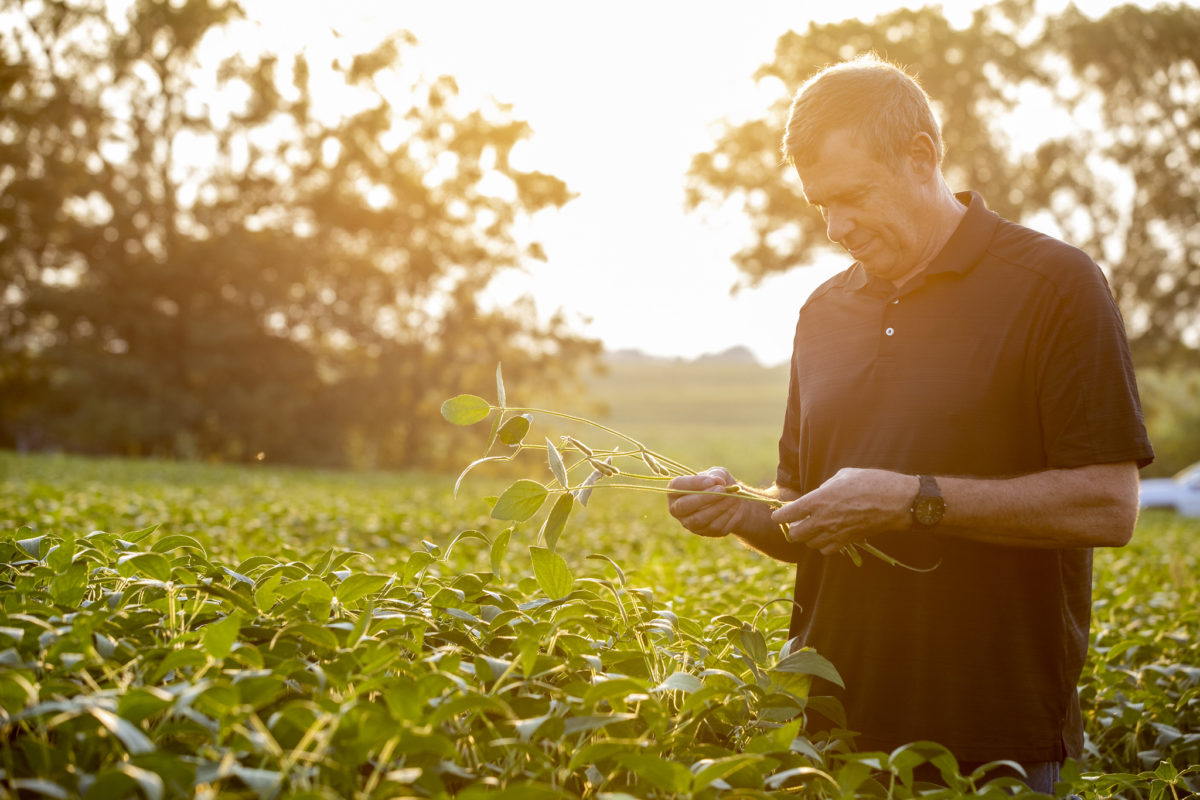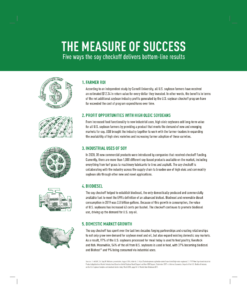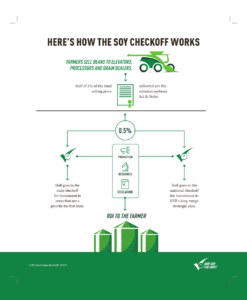Your Soy Checkoff 101: Creating Return on Your Investment

As a farmer, you have a lot of work that consumes your time and energy, including purchasing seed and making your plan for next season, preparing the ground and planting your crop, tending to your fields all season to produce a healthy, profitable crop, and taking your harvest to the elevator or storing it in bins to sell later. Your top priorities can’t also include new soybean research, education and promotional opportunities. However, those activities are crucial to maximizing your opportunities with soybeans. That’s where your soy checkoff — the United Soybean Board (USB) — comes in.
Your soy checkoff investment is managed by a group of farmers from soybean-growing states and regions across the country who act on behalf of all U.S. soybean farmers to increase profit opportunities and create a significant return on investment for farmers. When you sell soybeans to an elevator and processor, you’ve likely seen the line item on your sales ticket that indicates some of the value of your sale has gone to the checkoff.
Below is a rundown of what you need to know about your soy checkoff.
How do U.S. soybean farmers contribute to the checkoff?
Everyone who sells soybeans invests one-half of 1% of the total sale price of their soybeans into the checkoff fund. Half of these checkoff funds go to their state’s qualified state soybean board (QSSB), which invests the funds into priority areas for the state. The other half goes to the national checkoff for investment in its national strategic plan, which aligns with the checkoff’s objectives for investment in education, research and promotion opportunities for U.S. soy.
What work does the checkoff fund, and who makes that decision?
USB’s 78 farmer-leaders carefully review and approve projects designed to drive innovation, increase value and create additional demand for U.S. soybeans — ultimately increasing profitability for U.S. soybean farmers. Projects are chosen based on a combination of the likelihood of success, potential benefit to farmers and how well they align with the checkoff’s strategic goals for the industry.
“All these funds — state and national — are used for education, research and promotion, which bring value back to the soybean farmers. By law, none of these funds can be used for lobbying,” says USB Chair Dan Farney, who grows soybeans and corn in central Illinois.
Companies and organizations, such as those producing consumer packaged goods (CPGs), have a vested interest in sustainably sourced ingredients, including U.S. soy. To help these organizations understand that U.S. soybean farmers are sustainable and grow a sustainable ingredient, the checkoff works in collaboration with them, leveraging data to add credibility to farmers’ sustainability through programs such as the Sustainably Grown U.S. Soy mark.
Through education and promotion, the checkoff has established relationships across industries and supply chains, from consumers and industrial users of soy to CPG brands and public researchers, all to expand the market for U.S. soy. Additionally, checkoff-funded research allows your soy checkoff to join forces with organizations like The Goodyear Tire and Rubber Company to develop new products using U.S. soy, which grows demand for U.S. soybean farmers’ crop.
The checkoff also invests in building relationships and partnerships with other industries, such as animal ag, to build the market for soybean meal. This establishes a mutually beneficial relationship because it creates demand for soybeans through the use of soybean meal and provides those in the animal nutrition industry with a reliable product they can use to feed their livestock.
USB Treasurer Meagan Kaiser, who grows soybeans and corn with her husband and his family in Missouri, says these functions of the checkoff act as an extension of her farming operation, and do so for all U.S. soybean farmers.
“The checkoff allows individual producers to act as major corporations, supported by a research and development team, international demand-building endeavors, marketplace development programs and so much more,” Kaiser says. “It’s incredible that we have an investment in so many different areas and that our return is so great.”
An independent study by Cornell University in 2019 showed that U.S. soybean farmers received an estimated $12.34 in added value for every dollar they’ve invested in the checkoff.
“I think the thing that I’ve learned the most now is that we are driving demand and building preference for U.S. soy to maximize profitability for farmers. While we’re putting a small percentage in, we’re getting dollars back,” Kaiser says.
How does your soy checkoff provide value for U.S. soybean farmers?
Your ROI in the soy checkoff takes many different forms. While the checkoff has shown to provide financial ROI for U.S. soybean farmers, there is additional value the checkoff provides that can’t be so neatly attributed to dollars and cents.
For example, there are currently more than 1,000 different soy-based products available on the market that use commodity soybean oil and high oleic soybean oil, a specialty bean that produces oil with different qualities to match end-user needs. The checkoff continues to collaborate with the industry to broaden the use of soybean oil and meal through new high-volume applications.
Biodiesel is just one of the many soy-based products making a difference one gallon at a time. A recent study by the National Biodiesel Board, in cooperation with multiple QSSBs, found that switching to 100% biodiesel in the home-heating oil and transportation sectors would provide immediate community health improvements that can be measured in reduced medical costs and health care benefits. These findings further showcase U.S. soy’s performance and sustainability.
Since it was founded in 1991, the checkoff has forged partnerships to not only establish new demand for soybean meal and oil, but also expand existing markets. As a result of these efforts, 97% of U.S. soybeans processed for meal are used to feed poultry, livestock and fish, while 68% of U.S. soybean oil is used in food and 25% goes to biodiesel, and the remaining 7% is used in industrial uses.
The sustainability and performance of soy-based products is recognized domestically and internationally. The U.S. Soybean Export Council (USSEC), with support from the soy checkoff, is dedicated to optimizing the utilization and value of U.S. soy in international markets. USSEC fosters relationships with international customers, creating more markets and demand for your crop.
An extension of the farm
Farney says the support farmers provide the checkoff through their investments is mutually beneficial, as the checkoff works on behalf of those farmers.
“The percentage of farmers in the general population keeps growing smaller,” Farney says. “The checkoff gives farmers a voice to reach out and educate the general public. Another great thing about the checkoff is that it gives soybean farmers the ability to keep making innovative investments which will help keep soybean farming sustainable into the future.”
For more information about the investments of your soy checkoff, visit unitedsoybean.org.





